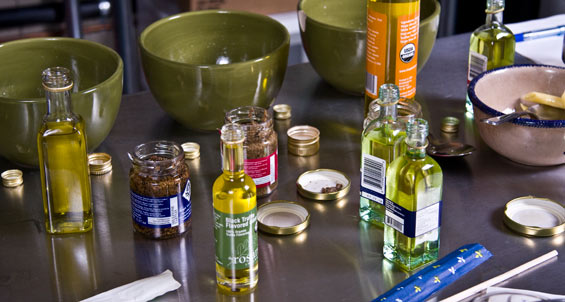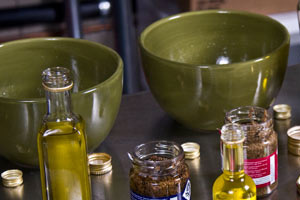
We recently tasted a good sampling of the truffle oils on the market. An expert guided us through the process. Here’s how to taste oils (or any fat) like the pros!
Four Tests for Truffle Oil Quality:
(compare oils of the same type (i.e. don’t compare white truffle oil to black truffle oil))
Straight Odor Test

1. Open up the truffle oil bottle.
2. Sniff the oil in the bottle, and consider the odor. It should smell pleasant, earthy, but not overpoweringly potent or aggressive.
3. Take a short break between smelling different oils, so your nose has a chance to reset.
What you’re looking for:
For a high quality oil, you’re looking for a well rounded, harmonious odor that doesn’t assault you. It should smell like fresh truffles, without notes of flowers, mushrooms, or petroleum.
Disturbed Odor Test

1. Smell an oil.
2. Gently blow a gust of air into the bottle.
3. Give it another sniff immediately after blowing on it, and note any changes in odor.
What you’re looking for:
Naturally produced truffle oil will maintain some of its odor at the same strength, while artificial oils will have a significantly weaker (or no) odor after you blow on them.
Heated Odor Test
1. Make sure your hands are clean, and (if you’ve just washed them recently) do not smell like soap.
2. Hold one of your hands palm down, and carefully pour just a drop of truffle oil onto the surface of your hand, in the webbing between the thumb and pointer finger.
3. Smell the oil.
4. Using the pointer finger on your other hand, vigorously rub the oil on your skin (where it sits, don’t spread it out to coat) in order to gently warm it.
5. Smell the oil again. Note any difference in intensity.
What you’re looking for:
Naturally produced truffle oil will develop a stronger odor when gently heated (just like fresh truffles). Artificially produced truffle oil will actually weaken as it heats up.
Taste Test
1. Cook some plain pasta. Truffle oil should be taste-tested with the food it was designed for.
2. Drizzle some of the oil on to the warm pasta. Use as much as you normally would.
3. Smell the pasta.
4. Taste the pasta.
What you’re looking for:
Smell=Flavor – The flavor your brain anticipates when smelling the truffle oil should be mirrored by what you actually taste. Again, well-rounded & harmonious is what you’re looking for, rather than elements of the flavor that seem too strong relative to the rest. It should also taste…well…natural.
Mouth Feel – Notice how the oil feels in your mouth, especially after you swallow. If you’re left with a petroleum-like feel in the back of your throat, it’s probably artificially flavored oil.
A Clean Finish – Wait for a few moments after you’ve swallowed your pasta. The truffle flavor should begin to gently dissipate, leaving you feeling warm and satisfied. If you find the flavor and the odor stick around for a long time, and especially if you find yourself burping truffle, you may have an artificially flavored oil. The flavorings used in artificial truffle oils aren’t actually digestible, so they tend to cling or reoccur later.
Post Written by Matthew Johnson
___________
Browse More:
Culinary Techniques
Truffle Recipes



Comments 2
the tasting, the chemical composition and background – this is great information to know – time to test my truffle oils.
Pingback: We get samples, you get samples « Justin Marx, CEO, MarxFoods.com